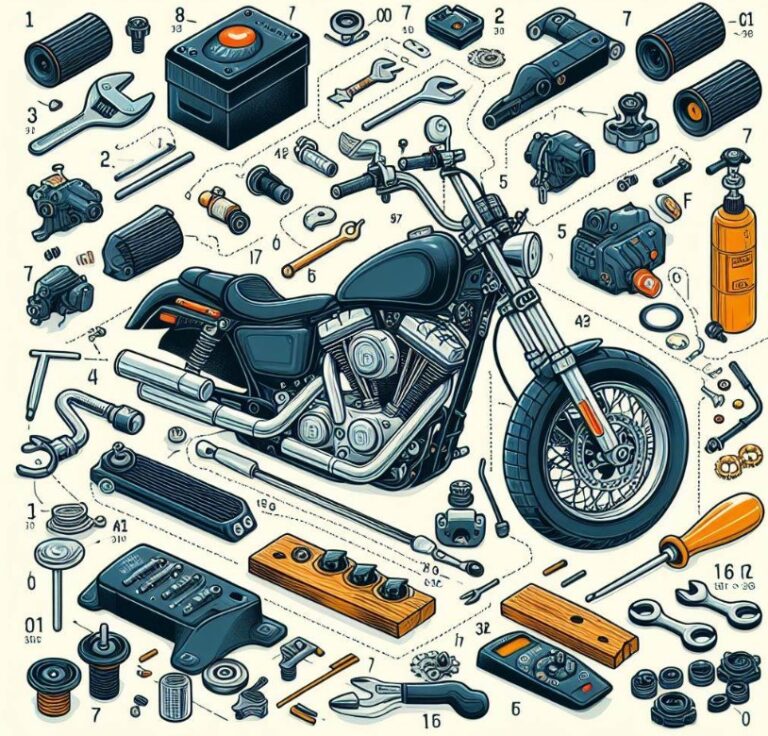What Is Step Through Bike? All You Need To Know
This article aims to provide information on What Is Step Through Bike? A step-through bike is a user-friendly bicycle design characterized by its low or absent top tube, facilitating easy mounting and dismounting. Ideal for a wide range of cyclists, this style caters especially to those who wear dresses or have mobility challenges. Its design promotes comfort and accessibility, making cycling an enjoyable activity for everyone.
Key Takeaways
- Step-through bikes offer easy mounting and dismounting.
- Ideal for riders with limited mobility or those wearing skirts or dresses.
- Features a low or absent top tube for easier access.
- Suitable for various riding conditions and audiences.
- Encourages a more upright riding position, reducing strain on the back and shoulders.
What Is Step Through Bike?
A step-through bike is a type of bicycle that features a low or non-existent top tube, allowing the rider to ‘step through’ the frame easily when mounting or dismounting, unlike traditional bikes that require lifting the leg over the saddle.

Evolution and Design
The design of step-through bikes has evolved significantly over the years. Initially, this design was aimed at women, allowing them to ride bikes while wearing skirts or dresses without compromising modesty.
However, the practicality and ease of use have made step-through frames popular among a much wider audience, including seniors and those with reduced flexibility.
The frame structure of these bikes is engineered for stability and comfort, making them a favorite for leisurely rides, urban commuting, and errand running.
Historical Context
The historical significance of the step-through bike cannot be overstated. In the early days of cycling, the step-through frame was a revolutionary design that enabled more people to ride bicycles, significantly impacting social mobility and independence.
Over time, the design has been refined to enhance comfort and accessibility, ensuring that the step-through bike remains a relevant and popular choice for contemporary cyclists.
Benefits of Step-Through Bikes
Step-through bikes are not just about ease of access; they offer a range of benefits that appeal to various riders. Firstly, they promote a more upright riding position, which is beneficial for the back and shoulders, leading to a more comfortable ride.
Additionally, the low frame makes these bikes an excellent option for city riding, where frequent stops are the norm. The design also lends itself well to carrying groceries, children, or other loads, as the lower center of gravity increases stability.
Comfort and Accessibility
The comfort and accessibility of step-through bikes make them an appealing option for a diverse group of riders. Whether you’re a daily commuter, a weekend adventurer, or someone looking for a leisurely ride around the neighborhood, the ergonomic design and ease of use of these bikes can enhance your cycling experience.
The step-through frame also makes these bikes a popular choice for bike-sharing programs, as they can accommodate riders of various sizes and abilities.
Types of Step-Through Bikes
There are several types of step-through bikes available, catering to different riding styles and preferences. City bikes, for example, are designed for urban environments, featuring gears and accessories that make city riding a breeze.
On the other hand, cruiser bikes focus on comfort and style, offering a relaxed ride with a distinctive vintage look. Hybrid bikes combine elements of road and mountain bikes, providing versatility and efficiency for a variety of riding conditions.
Choosing the Right Bike
Selecting the right step-through bike depends on your individual needs and riding habits. Consider factors such as the terrain you’ll be riding on, the distance of your typical ride, and any specific features you might need, such as gear options or accessory compatibility.
Consulting with a bike specialist can help you find a bike that fits your lifestyle and ensures a comfortable and enjoyable riding experience.
Safety and Maintenance
Safety and maintenance are crucial aspects of owning any bicycle, and step-through bikes are no exception. Regular checks and maintenance can keep your bike in top condition and help avoid accidents. It’s also essential to equip your bike with safety features like lights, reflectors, and a bell, especially if you’re riding in urban or crowded areas.
Tips for Safe Riding
Riding a step-through bike safely involves more than just routine maintenance. It’s important to follow traffic rules, wear appropriate gear, and be aware of your surroundings.
Additionally, investing in a good quality lock and learning proper locking techniques can protect your bike from theft, ensuring that it remains a reliable mode of transportation for years to come.
What Is The Difference Between A Step-Through Bike And A Normal Bike?
The primary difference between a step-through bike and a normal bike, often referred to as a step-over or traditional bike, lies in the frame design.
A step-through bike features a low or absent top tube (the bar between the seat and the handlebars), making it easier to mount and dismount the bike without lifting your leg high.

This design contrasts with the high-top tube on traditional step-over bikes, which requires riders to swing their leg over the rear of the bike to get on and off.
Step-through bikes are typically associated with ease of use, comfort, and convenience, catering to a wider range of riders, including those wearing skirts or dresses, older adults, or those with mobility limitations.
In contrast, traditional bikes are known for their rigidity and sportier design, often preferred for more aggressive riding or off-road activities due to their structural strength.
The choice between these bike types depends on personal needs, preferences, and the intended use of the bike. While step-through frames offer unparalleled accessibility, traditional frames are valued for their performance and classic aesthetic.
What Are The Downsides Of A Step-Through Bike?
While step-through bikes offer significant advantages in terms of accessibility and comfort, there are some downsides to consider. One potential drawback is that the lower frame can sometimes result in reduced structural rigidity compared to traditional step-over frames.
This can lead to more frame flex under certain conditions, particularly when riding at high speeds or on rough terrain, which might affect the bike’s handling and performance.
Another downside is the possible perception of style; some riders might view step-through bikes as less sporty or aggressive compared to traditional designs. Additionally, the unique frame shape of step-through bikes can limit the placement of water bottles or other accessories.
Finally, step-through bikes might be slightly heavier due to the additional materials needed to compensate for the lower frame design’s lack of a connecting top tube, which can affect the bike’s overall weight and portability.
Why Are Women’s Bikes Step-Through?
Historically, women’s bikes were designed with step-through frames to accommodate the skirts and dresses that were standard attire for women at the time. The lower frame allowed women to mount and dismount the bike more modestly and conveniently, maintaining decorum while still enjoying the benefits of cycling.

Today, while clothing norms have evolved, and many women comfortably ride step-over bikes, the step-through design continues to be popular for its ease of use, not just with women but with a broader audience.
It’s important to note that modern cycling embraces inclusivity, with the understanding that bike choice should be based on individual preferences, comfort, and riding style rather than strictly on gender.
Step-Through Vs. Step-Over Bikes: Which Is Better?
The debate between step-through vs. step-over bikes is not about which is objectively better, but rather which is better suited to an individual’s needs and cycling style.
Step-through bikes excel in terms of convenience, ease of access, and comfort, making them an excellent choice for casual riders, commuters, or those with mobility issues. They are particularly favored for urban environments where frequent stops are common.
On the other hand, step-over bikes are often preferred for their traditional aesthetic, structural rigidity, and performance, especially in sporting or off-road contexts. They are well-suited to riders who prioritize speed, agility, and the ability to tackle a variety of terrains.
Ultimately, the better choice depends on the rider’s priorities, physical needs, and intended use. Both styles have their place in the cycling world, and the best decision is the one that aligns with the rider’s lifestyle and comfort.
Conclusion
In summary, step-through bikes provide an inclusive cycling option that merges convenience, comfort, and style. They break down barriers to cycling, offering an accessible solution for diverse individuals, from casual riders to those with specific needs. As cycling continues to evolve, the step-through bike stands out as a testament to innovation and inclusivity in design.
Frequently Asked Questions
Can step-through bikes be used for long-distance rides?
Yes, step-through bikes can be used for long-distance rides, especially if they are comfortable and properly equipped. However, if you plan to embark on longer journeys, consider a model with multiple gears, a comfortable seat, and efficient tires. Ensure the bike is well-maintained and fitted correctly to your body to prevent discomfort during extended periods of cycling.
What maintenance is required for a step-through bike?
Maintenance for a step-through bike is similar to that of any bicycle and includes regular checks and adjustments to the brakes, tires, gears, and chain. Keeping the bike clean, lubricating moving parts, and promptly addressing any wear and tear will help extend its life and ensure safe operation.
Can I add accessories to a step-through bike?
Yes, you can add a variety of accessories to a step-through bike, including baskets, racks, fenders, lights, and more. These additions can enhance the functionality and comfort of your bike, making it more suitable for your specific needs, such as commuting or shopping.
How do I choose the right size step-through bike?
Choosing the right size involves considering the bike’s frame height, seat height, and handlebar position relative to your body measurements. It’s important to ensure that when seated, you can place both feet flat on the ground for stability, and when riding, your legs can fully extend during the pedal stroke. Visiting a bike shop for a professional fitting is recommended.

Welcome to the exhilarating world of Matt Rex, a professional car racer turned renowned vehicle enthusiast. Immerse yourself in his captivating blog as he shares heart-pounding adventures, expert reviews, and valuable insights on cars, trucks, jets, and more. Fuel your passion for speed and discover the beauty of vehicles through Matt’s engaging stories and meticulous expertise. Join the ever-growing community of enthusiasts who find inspiration and expert advice in Matt Rex’s blog—a digital hub where the thrill of speed meets the pursuit of knowledge.







